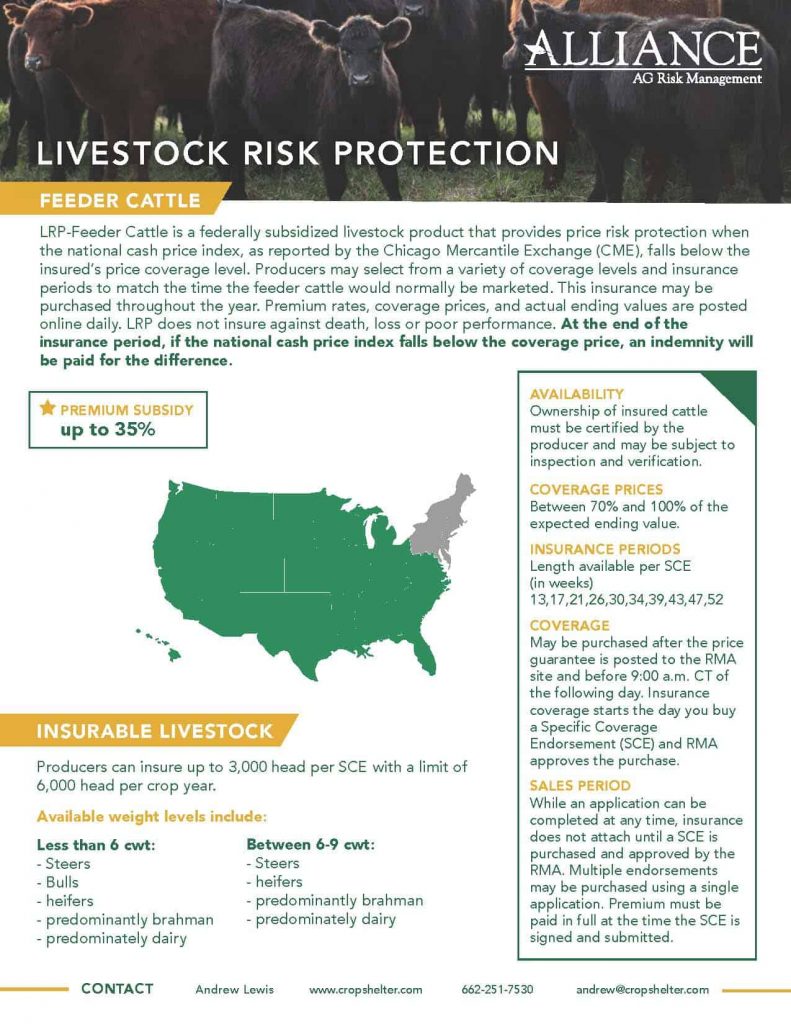Proactive Protection: Bagley Risk Management Techniques
Understanding Livestock Danger Security (LRP) Insurance Coverage: A Comprehensive Guide
Navigating the realm of animals risk security (LRP) insurance policy can be a complicated undertaking for lots of in the farming industry. From exactly how LRP insurance policy functions to the different protection options readily available, there is much to reveal in this thorough guide that might possibly form the means animals manufacturers come close to threat management in their businesses.

How LRP Insurance Policy Works
Sometimes, recognizing the technicians of Livestock Risk Protection (LRP) insurance policy can be intricate, but breaking down just how it functions can provide clarity for herdsmans and farmers. LRP insurance coverage is a danger monitoring device made to protect animals producers versus unanticipated price decreases. The policy permits producers to set a protection degree based upon their details requirements, selecting the variety of head, weight range, and insurance coverage price. As soon as the policy is in area, if market value drop below the protection rate, producers can sue for the difference. It is necessary to note that LRP insurance coverage is not an earnings guarantee; rather, it concentrates entirely on cost danger defense. The coverage period commonly ranges from 13 to 52 weeks, supplying adaptability for producers to select a duration that lines up with their manufacturing cycle. By making use of LRP insurance, herdsmans and farmers can mitigate the financial dangers related to rising and fall market costs, guaranteeing greater stability in their operations.
Qualification and Protection Options

When it comes to protection choices, LRP insurance policy offers manufacturers the flexibility to choose the protection level, coverage period, and endorsements that best suit their risk monitoring demands. By understanding the eligibility requirements and coverage choices offered, animals manufacturers can make informed decisions to take care of threat effectively.
Advantages And Disadvantages of LRP Insurance Policy
When evaluating Livestock Threat Protection (LRP) insurance policy, it is vital for livestock producers to consider the benefits and drawbacks integral in this threat administration tool.

Among the primary advantages of LRP insurance coverage is its ability to give security against a decline in animals prices. This can help safeguard producers from economic losses resulting from market fluctuations. Furthermore, LRP insurance coverage supplies a level of adaptability, enabling producers to personalize protection degrees and plan periods to match their particular needs. By locking in an assured rate for their animals, manufacturers can better manage danger and prepare for the future.
One restriction of LRP insurance is that it does not protect against all types of threats, such as disease break outs or natural disasters. It is essential for manufacturers to meticulously examine their individual threat exposure and financial situation to determine if LRP insurance coverage is the best threat management device for their operation.
Comprehending LRP Insurance Policy Premiums

Tips for Taking Full Advantage Of LRP Conveniences
Making best use of the benefits of Animals Danger Security (LRP) insurance policy calls for tactical preparation and aggressive danger administration - Bagley Risk Management. To take advantage of your LRP insurance coverage, consider the following suggestions:
Regularly Assess Market Conditions: Remain notified about market fads and cost changes in the animals market. By checking these factors, you can make informed decisions concerning when to acquire LRP insurance coverage to secure versus prospective losses.
Establish Realistic Protection Levels: When choosing protection levels, consider your production expenses, market price of livestock, and potential threats - Bagley Risk Management. Establishing practical insurance coverage degrees makes sure that you are properly safeguarded without overpaying for unneeded insurance coverage
Diversify Your Coverage: As opposed to depending only on LRP insurance, think about expanding your risk management strategies. Incorporating LRP with various other risk management devices such as futures contracts or options can give thorough Source insurance coverage against market unpredictabilities.
Evaluation and Adjust Insurance Coverage Routinely: As market conditions transform, regularly evaluate your LRP insurance coverage to ensure it aligns with your existing risk direct exposure. Changing coverage degrees and timing of purchases can aid enhance your risk defense method. By following these ideas, you can make best use of the benefits of LRP insurance and guard your livestock procedure against unexpected threats.
Final Thought
In conclusion, animals danger defense (LRP) insurance coverage is an important device for farmers to manage the economic threats connected with their livestock procedures. By comprehending just how LRP functions, qualification and coverage alternatives, as well as the advantages and disadvantages of this insurance, farmers can make educated choices to protect their incomes. By meticulously taking into consideration LRP premiums and applying methods to maximize benefits, farmers can mitigate possible losses and guarantee the sustainability of their procedures.
Livestock manufacturers interested in acquiring Animals Risk Protection (LRP) insurance can discover a variety of eligibility standards and coverage alternatives customized to their certain animals procedures.When it comes to protection alternatives, LRP insurance coverage uses producers the adaptability to choose the coverage level, protection duration, and recommendations that ideal match their risk management needs.To grasp the details of Animals Risk Defense (LRP) insurance totally, understanding the aspects influencing LRP browse around this web-site insurance costs is important. LRP insurance premiums are identified by numerous elements, including the protection degree picked, the expected rate of livestock at the end of the protection period, the type of animals being insured, and the size of the protection duration.Evaluation and Change Coverage Frequently: As market problems alter, periodically review your LRP protection to guarantee it aligns with your existing risk direct exposure.